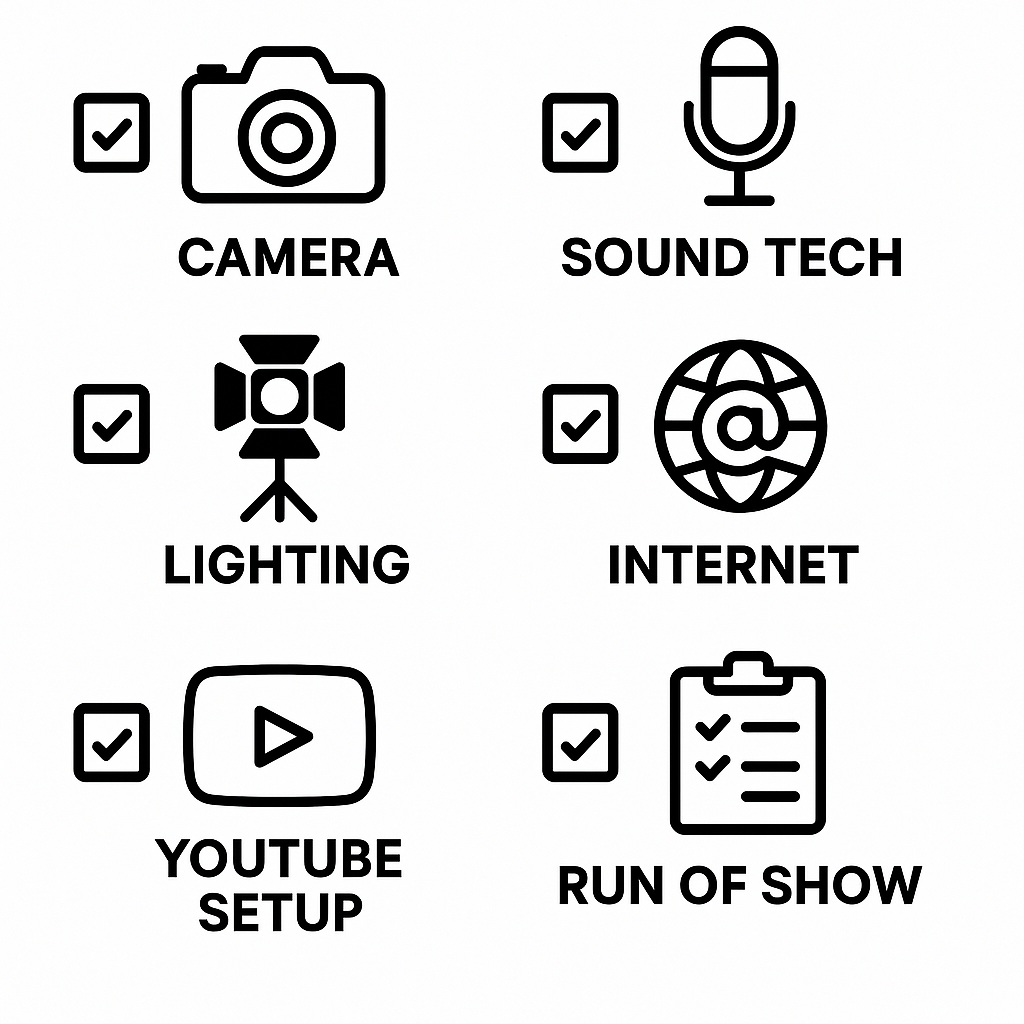Client Checklist for a Flawless YouTube Livestream Event
Hire a Professional Livestream Team
The first step in pulling off a solid YouTube livestream is to build the right team. At a minimum, that includes:
Camera operator(s): Depending on your event’s size and complexity, you might need a single operator or multiple operators for various angles.
Audio technician: Relying on a venue's in-house system can be hit or miss. A dedicated sound technician can balance the room and live mix—critical if your event includes multiple microphones, musical instruments, or panel discussions.
Lighting: Work with either your video production team or the venue to ensure the stage or filming area is lit properly for camera. Dark venues result in poor video quality.
Provide Strong and Reliable Internet
Livestream success lives or dies by the internet connection. Here's what we need from your side:
Wired Ethernet is the most stable and preferred connection.
Wi-Fi should be private, with guest access restricted during the stream.
We bring our own cellular bonding gear, which combines Ethernet, Wi-Fi, and multiple carrier signals into one strong, redundant livestream connection.
We aim to hardwire all cameras and audio to limit signal interference—wireless gear should only be used when necessary and pre-tested.
YouTube Setup and Access
Decide early whose YouTube channel will host the livestream. If your channel has never streamed before, livestreaming must be manually enabled—and that process can take 24–48 hours.
If you're using your own YouTube:
Is it livestream-enabled yet? If not, enable it early.
Will your team manage the livestream backend? If not, we’ll need admin access or manager access.
To add us as a YouTube Manager:
Go to YouTube Studio
Click Settings > Permissions
Invite our email and assign the Manager role
Avoid relying on logins that require offsite two-factor authentication—this can block us from going live if credentials or phone codes aren’t accessible on-site.
If needed, we can stream from our own YouTube account as a fallback.
Don’t Share the YouTube Link Directly
Instead of sending viewers the direct YouTube video link, embed the livestream into a landing page or blog post on your site.
Why?
If a stream fails or crashes, YouTube won’t let us restart it under the same link. Anyone with the old link will be stuck. But if it’s hosted on your own page, we can simply drop in the new stream link on the backend and tell users to refresh the page—no email blast or re-linking needed.
Thumbnail, Titles, and Pre-Event Setup
Create a thumbnail graphic in advance, or have us design it.
Add the stream title, description, location, date/time, language, and any keywords you want to target for SEO or press.
If you plan to reuse the video later (such as for PR), draft a second post-event description and save it for upload later.
Any titles, bugs, or watermarks you want on the video must be sent to us well in advance—last-minute changes during the stream are risky and discouraged.
Keynote and Presentation Slides
If you’re using a PowerPoint or keynote presentation during the livestream:
Let us know what computer will be used
We’ll need to test the video output beforehand
Every computer is different—some need special adapters or settings adjustments
The more prep time we have, the smoother this runs
Media Assets and Pre-Roll Content
If you'd like us to show media before the livestream—such as promo videos, sponsor content, or looping announcements—send it to us in advance. These assets will be played during the pre-roll period before your event begins.
Run of Show and Event Coordination
We rely on a clear Run of Show to understand what’s happening when:
Will there be a Q&A session?
Are there speaker transitions?
Is there a panel or award ceremony?
Will there be any live demonstrations or slides?
This helps us time our camera switching, prep the livestream overlays, and create a professional viewer experience.
Livestream Execution
We typically go live 15–20 minutes before the event begins to let viewers know they're in the right place. During this time, we run a looping video or still graphic with music.
At showtime, we give a “3, 2, 1” cue to the emcee or speaker and fade into the live portion. This coordination makes the event feel polished from the first second.
Post-Event Deliverables and Editing
We record two things:
Program feed – This is what was seen during the livestream, complete with switching and overlays.
Raw camera feeds – These are higher quality than the livestream and ideal for post-editing.
If you're planning to use this footage again—especially for marketing or PR—we highly recommend having us edit a final version using the high-quality original camera files. Livestreams are compressed and not ideal for long-term use.
Final Thoughts
Executing a high-quality livestream on YouTube isn't just about pointing a camera and hitting “Go Live.” It’s a coordinated effort between your team and ours to ensure the technology, creative elements, and logistics all come together seamlessly. When done right, a livestream can elevate your message, expand your reach, and create content that lives far beyond the day of the event.
If you're planning an upcoming livestream and want a partner who can handle the heavy lifting—tech, production, and strategy included—reach out to us. We’ll walk you through the right setup for your goals and budget, and deliver a polished result your audience will actually want to watch.
Ready to get started?
Contact us today to schedule a discovery call and build a livestream plan tailored to your event.



